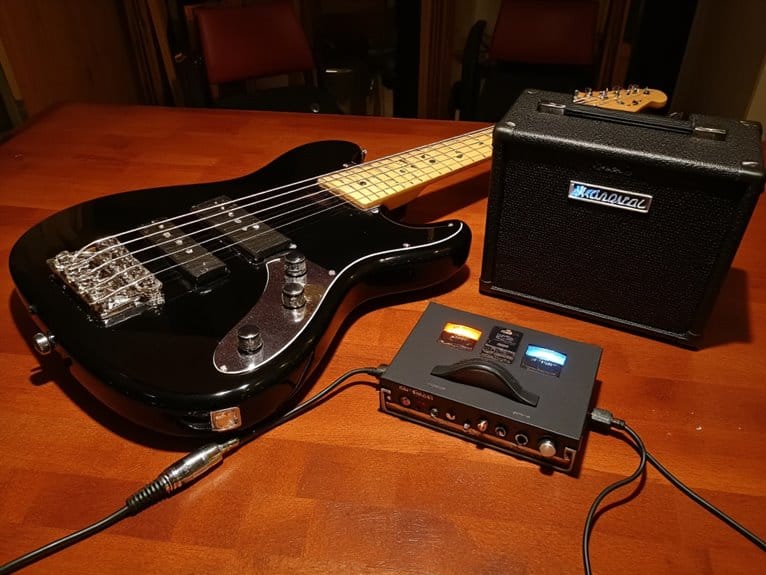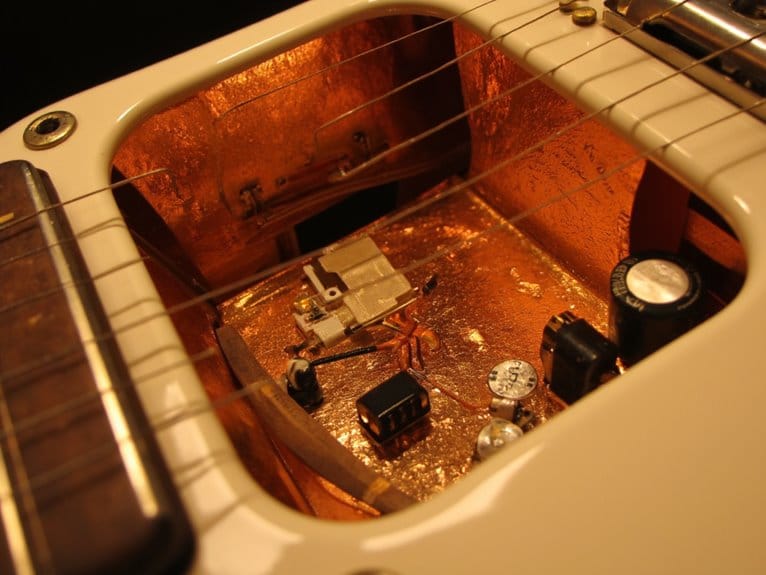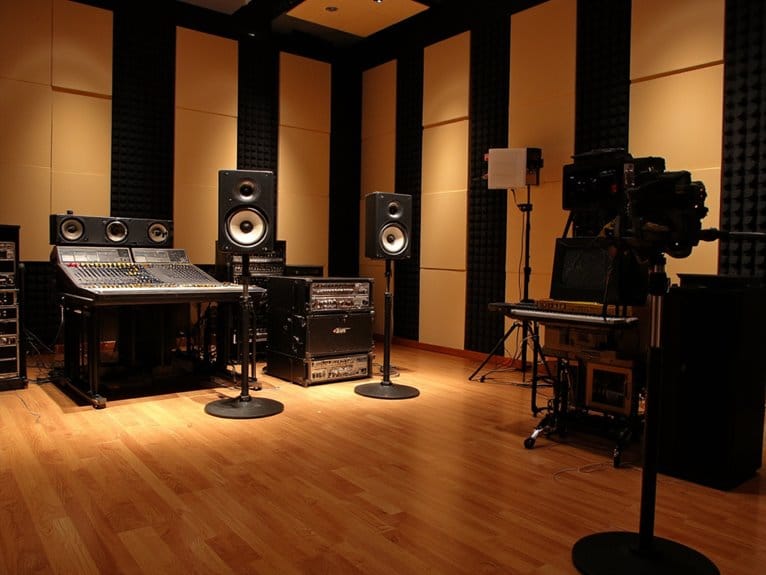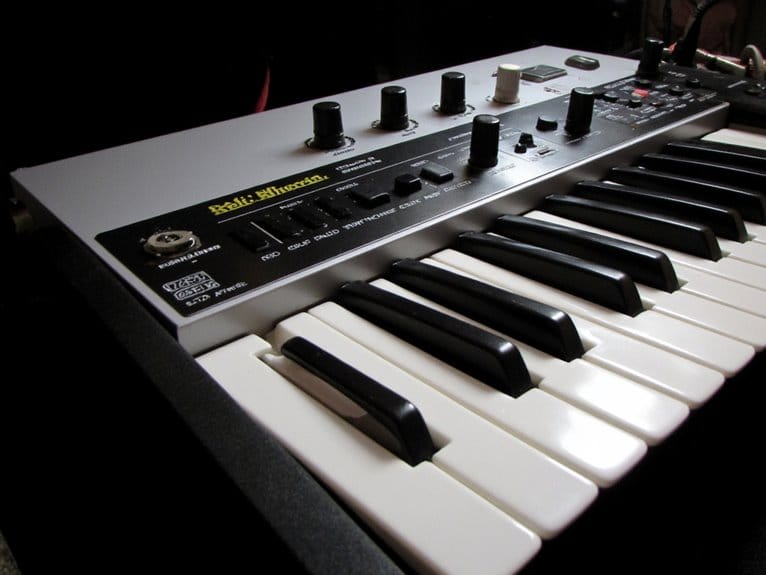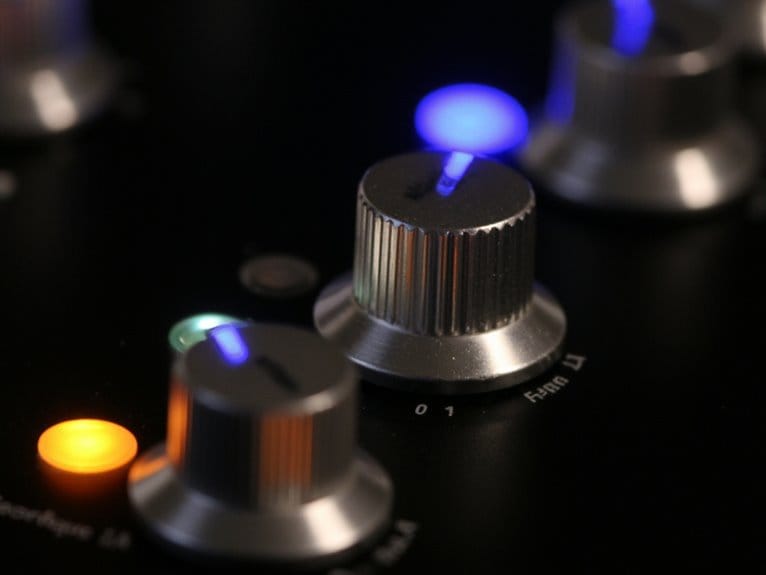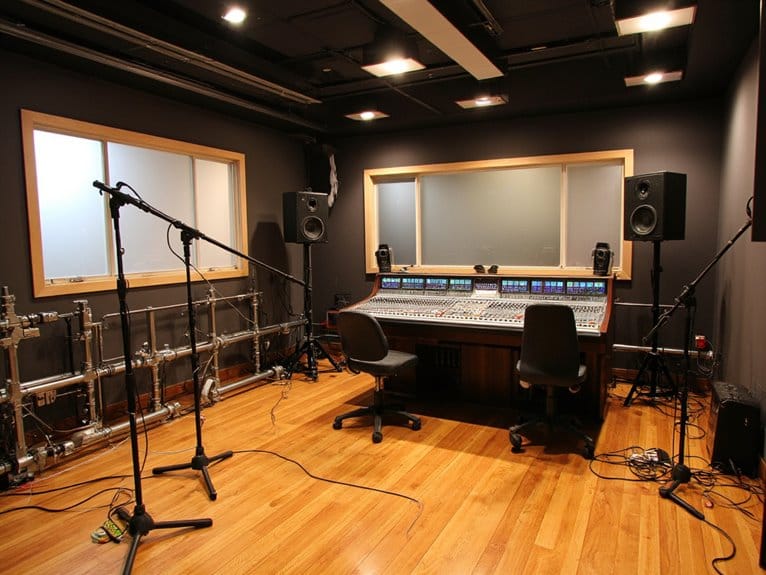Compact Drum Kit Configurations for Limited Spaces
You’ll maximize your drumming potential in tight spaces by choosing models like the Pearl Midtown or Tama Club-JAM, which feature 6-ply construction and ultra-compact designs that don’t compromise sound quality. Position your throne so thighs stay parallel to the floor, place rack toms close for smooth shifts, and tune shells higher than traditional setups to cut through room reflections. These configurations enable subway-friendly transport while delivering surprisingly powerful acoustic performance that’ll impress you once you explore the complete setup strategies.
We are supported by our audience. When you purchase through links on our site, we may earn an affiliate commission, at no extra cost for you. Learn more.
Notable Insights
- Popular compact models like Pearl Midtown, Tama Club-JAM, and Ludwig Breakbeats maximize sound quality while minimizing footprint.
- Suspension mounts and adjustable tom positioning optimize resonance and ergonomic accessibility within tight spatial constraints.
- Proper throne height and close snare placement ensure natural wrist movement and neutral spinal alignment during play.
- Higher tuning and acoustic treatment materials help compact kits cut through small room reflections and control muddiness.
- Lightweight designs enable single-trip transport and subway-friendly portability for gigging drummers with limited vehicle space.
Popular Compact Drum Kit Models and Features
When I first started researching compact drum kits, I’ll admit I was skeptical about whether these smaller setups could deliver the sound quality that serious drummers need.
But after testing dozens of models, I’ve found that today’s compact kits offer remarkable versatility without the space demands of traditional full-size sets.
Through extensive kit comparisons, I’ve identified standout models that consistently meet diverse user preferences.
The Pearl Midtown leads with its balanced approach, offering professional-grade materials in a portable package that works equally well for beginners and seasoned players. The kit’s 6-ply Poplar construction provides the foundation for its versatile performance across multiple music genres.
For practice sessions in noise-sensitive environments, many drummers complement their compact acoustic setups with practice pads that feature realistic rebound and sound simulation capabilities. Many players also turn to electronic options that offer mesh pads for an authentic acoustic feel while maintaining apartment-friendly sound levels.
Tama’s Club-JAM series excels in ultra-compact designs, while Ludwig’s Breakbeats brings Questlove’s urban influence to smaller spaces, and Sonor’s AQ2 Safari delivers maple shell resonance in jungle-inspired configurations. These super compact options typically feature 14in to 16in bass drums and are particularly ideal for apartment dwellers or frequent travelers.
Design Characteristics for Space-Constrained Environments
Since space constraints fundamentally reshape how drummers approach kit design, I’ve learned that successful compact configurations rely on three critical engineering principles: maximizing acoustic output per square foot, optimizing ergonomic accessibility within tight boundaries, and maintaining structural integrity despite reduced hardware footprints.
Design innovations like suspension mounts enhance resonance while keeping shells compact, and adjustable tom positioning guarantees you’ll maintain comfortable reach angles even in cramped quarters.
Sound dynamics benefit from specialized drum heads such as Evans EMAD systems, which deliver punchy bass response from smaller shells, while 7-ply maple construction preserves tonal clarity despite reduced dimensions. Modern compact kits like the Pearl Compact Traveler achieve impressive 20-pound weights while maintaining full acoustic capabilities for space-conscious drummers.
Quick-setup hardware becomes essential when you’re working within 3′ x 5′ spaces, and modular components let you adapt configurations based on specific venue constraints without compromising performance quality.
Setup Optimization and Ergonomic Considerations
Although compact drum kits solve space challenges effectively, I’ve discovered that poor ergonomic setup can quickly convert your streamlined configuration into a physical nightmare that’ll leave you cramped, fatigued, and fighting your own equipment.
Your throne height becomes critical—adjust it so your thighs sit parallel to the floor, enabling natural leg motion while maintaining neutral spinal alignment. Position your snare drum close to your body with a slight angle, allowing natural wrist movement without overreaching.
Setup customization includes placing rack toms as close as possible to facilitate smooth shifts, while your floor tom should angle inward for easy access. Smart ergonomic tools like quick-release memory locks, lightweight hardware, and telescoping stands maximize comfort while maintaining your compact footprint.
Acoustic Performance in Small Room Settings
While compact drum kits excel at solving space constraints, their acoustic performance in small rooms presents a unique set of challenges and advantages that I’ve learned to navigate through years of cramped studio sessions and apartment practice spaces.
You’ll find that smaller shells naturally emphasize mid and high frequencies, which actually works in your favor since small rooms tend to muddy low-end frequencies anyway.
Strategic acoustic tuning becomes vital—I typically tune my compact kit higher than I’d a full-size setup, yielding clearer, more articulate tones that cut through room reflections.
Sound absorption materials like acoustic panels and bass traps aren’t just helpful, they’re essential for controlling the pronounced reflections that can make even the best compact kit sound amateur.
When recording in these tight quarters, cardioid patterns on your microphones become crucial for isolating individual drum elements and preventing the room’s natural reverb from overwhelming your recordings.
Transport Benefits and Practical Applications
When it comes to moving your kit from point A to point B, I can’t overstate how much easier life becomes once you’ve experienced the liberation of truly portable drums.
Transport logistics transform from a dreaded chore into something manageable, especially when you’re dealing with tight venue spaces or last-minute gig calls.
The gigging advantages become immediately apparent:
- Subway-friendly sizes – carrying your entire kit on public transport without looking like you’re moving apartments
- Single-trip load-ins – eliminating those exhausting back-and-forth hauls from your car trunk
- Backstage tetris mastery – fitting comfortably in cramped green rooms alongside other bands’ gear mountains
- Quick-escape artistry – packing up while the crowd’s still applauding, not three hours later
- Personal vehicle compatibility – actually closing your hatchback without requiring engineering calculations
Frequently Asked Questions
What Budget Range Should I Expect for Quality Compact Drum Kits?
You’ll find quality compact kit features starting around $600-1,200 for mid-tier options with decent sound quality. Entry-level kits begin at $300, while premium models exceed $1,200 for professional-grade performance and durability.
How Do I Maintain and Care for Compact Drum Hardware?
You’ll need regular hardware storage solutions and consistent maintenance tips including weekly cleaning with glass cleaner, monthly lubrication of tension rods, and proper disassembly for thorough dust removal from all components.
Can I Upgrade Compact Kits With Larger Shells Later?
You can upgrade compact kits with larger shells later through modular designs and shell upgrades. Electronic kits offer easier compact enhancements, while acoustic upgrades require compatible hardware and space considerations for successful expansion.
What Cymbals Work Best With Small Drum Configurations?
You’ll find the best cymbal types for small setups include brass models in compact cymbal sizes like 8″ hi-hats, 10″ crashes, and 14″ rides. They’re quieter, brighter, and won’t overpower your drums.
On a final note
You’ve got everything you need to transform cramped practice spaces into productive drumming environments. Whether you’re dealing with apartment constraints, studio limitations, or transport challenges, compact kits deliver surprising acoustic performance without sacrificing playability. I’ve seen countless drummers discover that downsizing doesn’t mean compromising—it means optimizing. Your space limitations aren’t obstacles; they’re opportunities to explore efficient configurations that’ll enhance your playing experience and keep the neighbors happy.


